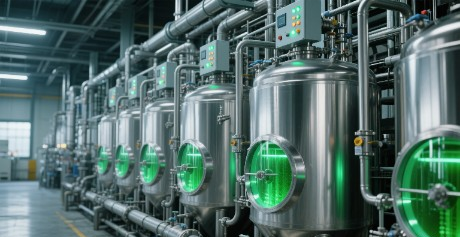The dawn of industrial civilization emerged when James Watt’s steam engine unleashed the first rays of mechanical power, revolutionizing human history. Today, as the digital wave surges forward with overwhelming momentum, it heralds the advent of the “Fourth Industrial Revolution.” According to Academician Zheng Yuguo of the Chinese Academy of Engineering, this transformation is driven by breakthroughs in artificial intelligence, biotechnology, and other frontier fields, with synthetic biomanufacturing playing a pivotal role in reshaping industrial production paradigms.
The Core of the Fourth Industrial Revolution
The First Industrial Revolution was marked by the widespread adoption of steam power, the Second by electrification, and the Third by atomic energy and computers. While the Third Industrial Revolution continues to unfold, the Fourth is already underway—characterized by artificial intelligence, new materials, molecular engineering, virtual reality, quantum information, and biotechnology. Its essence lies in enhancing resource productivity, reducing pollution emissions, and transforming lifestyles.
At the heart of this revolution is synthetic biomanufacturing, an interdisciplinary field that applies engineering principles to design, modify, or even reconstruct biological systems. By reprogramming cellular machinery, scientists can achieve precise and efficient synthesis of target molecules, revolutionizing traditional manufacturing processes.
Transforming Fine Chemical Industries
Synthetic biomanufacturing is catalyzing a paradigm shift in pharmaceuticals, agrochemicals, food production, and materials science. Unlike conventional petrochemical routes, bio-based production reduces energy consumption by 30-50%, with future potential reaching 50-70%. A prime example is the replacement of traditional metal catalysts with enzyme-based systems, such as nitrile hydratase for acrylamide production—a technology pioneered by Academician Shen Yinchu in the 1980s. This innovation not only eliminated the need for copper catalysts but also enabled large-scale, energy-efficient manufacturing of polyacrylamide for water treatment and oil extraction.
Key Innovations Driving Industrial Transformation:
-
Microbial Cell Factories: Engineered strains like E. coli and yeast are optimized to produce high-value compounds such as L-methionine, an essential amino acid with a global demand of 1.7 million tons (¥33 billion market). Zheng Yuguo’s team developed a fermentation-enzyme coupling system yielding 140 g/L of precursor (OSH) with 80% sugar-acid conversion, setting an international benchmark.
-
Enzyme-Catalyzed Processes: The “gas-phase synthesis—multi-enzyme cascade” technology for L-glufosinate production, commercialized by Jiangsu Limin, achieves >99% yield and 100% optical purity, outperforming chemical synthesis in cost and sustainability.
-
Hybrid Chemo-Bio Routes: Insulin and atorvastatin calcium are now produced via integrated chemical-enzymatic methods, combining the precision of synthetic biology with the scalability of traditional chemistry.
Economic Potential and Global Impact
The synthetic biology market reached $17 billion in 2023, growing at 28.8% annually, and is projected to generate trillions in economic value by 2100. In China, initiatives like the “Yangtze River Delta Synthetic Biomanufacturing Corridor” have already spurred a ¥100 billion industrial cluster (2024), with expansions underway.
Policy and Collaborative Frameworks
Governments worldwide are prioritizing synthetic biomanufacturing:
-
China’s 14th Five-Year Plan for Bioeconomy emphasizes industrial biotechnology to decarbonize chemicals, materials, and energy.
-
U.S. Bioeconomy Executive Order (2022) targets 30% chemical production via biomanufacturing by 2043.
-
EU’s Industrial Biotechnology Roadmap aims for 25% bio-based chemical substitution by 2030.
Public-private partnerships, such as Zhejiang University-Industry Innovation Centers and the National Innovation Center for Biotechnology in Suzhou Industrial Park, are accelerating R&D translation. The Park’s 2025-2027 Biomanufacturing Action Plan aims to nurture 5 leading enterprises and 150 high-growth firms, targeting ¥15 billion in output.
Challenges and Future Directions
Despite progress, hurdles remain:
-
Scalability: Non-model microbial hosts (e.g., Halomonas) require tailored genetic tools for industrial deployment.
-
Cost-Effectiveness: As Academician Ma Dawei notes, synthetic biology must target high-volume commodities (e.g., pesticides, feed additives).
-
Convergence with AI: Machine learning is critical for strain optimization and pathway design.
Conclusion:
Synthetic biomanufacturing is not merely a technological upgrade—itfundamental restructuring of industrial systems. By decoupling production from fossil fuels, minimizing waste, and enabling circular economies, it epitomizes the “Green Productivity” central to China’s new quality productive forces strategy.









